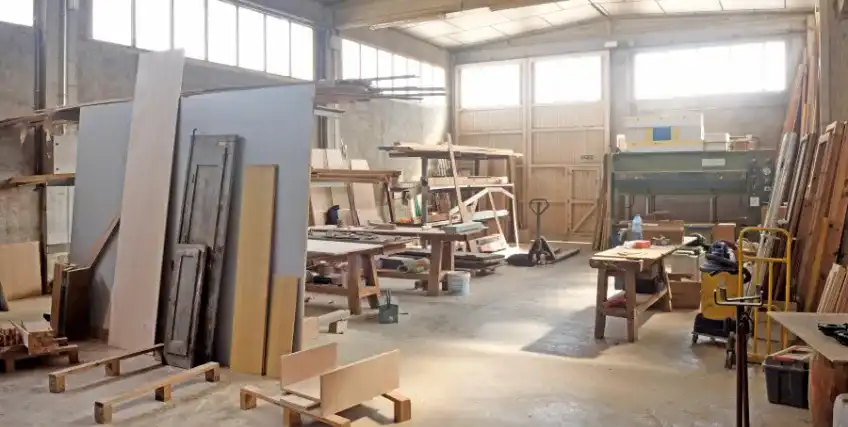How to Use a Business Loan to Expand Your Carpentry Services
Sep 30, 2025 | Last Updated on: Oct 1, 2025

Your projects might stack up, clients may expect more, and expanding services can feel like a challenge. At this point, relying only on savings or credit cards might not be enough for your business.
To overcome all these obstacles, carpentry business financing can provide the financial boost you need for your business. It covers a variety of loan options including carpentry business expansion loan, equipment loan for carpentry, or small business loans for carpenters. You can use funds from these financing options to hire skilled staff, purchase new equipment, or invest in commercial real estate. Moreover, financing helps strengthen your cash flow and helps you take on larger projects confidently.
Whether you're running a woodworking shop or a full fledge carpentry business, with the right carpentry business financing option you can turn your growth vision into reality. In this article, we'll see why financing for carpentry business is important, the different types of loans available, and smart ways you can use them to expand your services.
Why Financing Matters in the Carpentry Industry
Accessing carpentry business financing options allows you to maintain working capital while growing your business simultaneously. You can use these financing options to:
- Upgrade equipment purchases to handle more complex woodworking projects.
- Hire additional carpenters or administrative staff to increase efficiency.
- Expand into commercial real estate for larger or multiple projects.
- Invest in marketing to attract new clients and retain repeat business.
Different carpentry business financing options like a business line of credit, short-term loans, or equipment financing can help stabilize cash flow. However, before considering any funding option, it is important for you to understand the repayment terms, monthly payments, and interest rates so that you can ensure your loan contributes to growth rather than stress.
Clarifying Your Business Needs Before Borrowing
Before you apply for carpentry business financing options, you need to fully understand your business needs to make the process smoother. Borrowers who plan carefully often experience a simpler loan application process and better outcomes.
Therefore, before considering carpentry business financing solutions, ask yourself:
- Do you need new equipment to take on more or larger projects?
- Would hiring more staff improve efficiency and client satisfaction?
- Could expanding your real estate or workshop support growth?
- Is extra working capital needed for seasonal demand or short-term expenses?
Exploring Carpentry Business Financing Options
Here are some of the different types of carpentry business financing options available. You can choose the right option for your carpentry business, depending on your goals and needs.
SBA Loans
SBA loans are backed by the U.S. Small Business Administration and offer lower interest rates with longer repayment terms to qualified business owners. These loans are ideal for carpentry business expansion and larger investments.
- Used for: SBA loans can be used to purchase equipment, commercial real estate, working capital, or hiring staff.
- Eligibility: To qualify for this carpentry business financing option, you need a strong credit history, detailed business plan, and consistent revenue from your carpentry business.
Business Line of Credit
A business line of credit is a flexible funding option that offers easy access to funds up to a set credit limit. Here you pay interest only on the amount used. As a result, this helps you manage cash flow efficiently.
- Used for: A line of credit can be used for short-term working capital, seasonal expenses, or urgent projects.
- Eligibility: You need a strong personal credit score, proof of revenue, and clear understanding of your business needs to qualify for this carpentry business financing option.
Equipment Financing
Equipment financing is a business funding option that lets you purchase business assets like tools, machinery, or tech. Instead of paying upfront for the equipment, you can spread the cost in manageable monthly payments over time.
- Used for: Equipment financing can be used to purchase used or new equipment like CNC machines, saws, or lathes.
- Eligibility: For this carpentry business financing option, you need to have a good credit history, manageable loan amount, and a plan for equipment use.
Term Loans
Term loans provide a lump sum loan amount that often comes with fixed rates and fixed repayment terms. These loans are suitable for medium or long-term investments.
- Used for: Term loans can be used to hire skilled staff, expand services, purchase commercial real estate, or buy equipment.
- Eligibility: To qualify for this carpentry business financing option, you need to have a stable credit history, proof of revenue, and a clear business plan.
Working Capital Loans
Working capital loans are short-term loans that offer quick access to funds. However, these loans typically have higher interest rates.
- Used for: Working capital loans can be used to cover day-to-day operational expenses, small construction, or immediate project needs.
- Eligibility: You need to demonstrate business revenue, manageable monthly payments, and understanding of repayment terms to qualify for this carpentry business financing option.
Not only these, but some credit unions also offer competitive financing options for your carpentry business. While not part of traditional SBA loan programs, they can be valuable for business owners who prefer local lenders. Also, certain non-profit woodworking initiatives or community carpentry workshops may also qualify for specialized loan programs.
Smart Ways to Use Your Loan
Applying carpentry business financing funds strategically ensures growth without stress:
- Upgrade Equipment: Invest in new equipment to improve precision, productivity, and project scope.
- Hire Staff: Bringing in carpenters or office support increases capacity and efficiency.
- Expand Services: Offering custom furniture, cabinetry, or restoration work attracts more clients.
- Marketing and Outreach: Promoting services fills the increased capacity and strengthens your brand.
Managing Your Loan Effectively
Proper management ensures your loan drives growth. Moreover, being disciplined with your loan ensures it strengthens your business rather than creating stress.
- Budget Your Loan Amount: Allocate funds for equipment purchases, staffing, marketing, or working capital.
- Monitor Cash Flow: Track revenue, expenses, and monthly payments to stay on top of loan repayment.
- Refinancing: If interest rates drop, refinancing may reduce monthly payments or extend repayment terms.
- Professional Guidance: Your lender or financial advisor can help optimize your loan program and repayment terms.
Avoiding Common Pitfalls
Even with planning, mistakes can occur when seeking carpentry business financing options. So, always watch out for:
- Borrowing Too Much: Excess funds can strain cash flow.
- Ignoring Interest Rates: High interest rates make repayment difficult.
- Overlooking Terms: Understand all repayment terms to avoid surprises.
- Credit Concerns: Poor personal credit score or weak credit history may reduce your loan amount or eligibility.
- Misuse of Funds: Keep the loan for business purposes, like equipment purchases, staff, or working capital.
The Bottom Line
Growth in the carpentry industry requires both skill and strategy. A carpentry business financing option can help you fund equipment purchases, staffing, service expansion, and marketing.
So, before seeking carpentry business loans, you need to have evaluate different financing options, understand eligibility, and plan loan repayment that ensures the borrowed funds strengthen your business. Because every investment in tools, staff, or workspace increases capacity, revenue potential, and reputation.
You can explore SBA loans, term loans, business lines of credit, or equipment financing. By managing monthly payments, reviewing repayment terms, and focusing on your business needs, a loan can help you reach your expansion goals. Hence, start growing your carpentry business by reviewing small business loan programs or other carpentry business financing options.
FAQs About Carpentry Business Financing Options
What is a carpentry business loan, and how does it work?
A carpentry business loan is funding you borrow to support your woodworking or carpentry shop. You receive a loan amount upfront or access money through something like a business line of credit. In return, you make monthly payments based on agreed repayment terms and interest rates. When used wisely, the loan covers business purposes such as buying new equipment, expanding your workshop, or managing cash flow.
How much can I borrow for my carpentry business?
Your loan amount depends on your business needs, credit profile, and the lender's requirements. For example, if you need equipment financing, the loan usually matches the cost of the new equipment. If you're planning a major carpentry business expansion loan, like purchasing commercial real estate, the loan amount can be much larger. The key is to match your funding to your goals, not just borrow the maximum available.
What do lenders look at when I apply?
During the application process, your lender reviews several things. Your personal credit score and credit history play a big role. They also check your business plan, revenue, and ability to make monthly payments. Having organized financial records and a clear plan for how the funds will support your carpentry business helps a lot. Strong preparation can improve your eligibility for better funding options.
How can I use a carpentry business loan wisely?
The smartest way is to focus on growth-driven business purposes. That could mean buying new equipment, investing in commercial real estate, or hiring staff. Some borrowers use funds for marketing, training, or even refinancing existing debt to secure lower interest rates. The goal is to create measurable improvements in your business, not just cover short-term gaps.
Can I refinance an existing carpentry loan?
Refinancing is an option for an existing loan if you find better interest rates or want longer repayment terms. Many business owners refinance to lower monthly payments or free up working capital. Just make sure the costs of refinancing don't outweigh the benefits. Talking with your lender about current types of loans available can help you decide if refinancing makes sense.
Frequent searches leading to this page
Term Loans are made by Itria Ventures LLC or Cross River Bank, Member FDIC. This is not a deposit product. California residents: Itria Ventures LLC is licensed by the Department of Financial Protection and Innovation. Loans are made or arranged pursuant to California Financing Law License # 60DBO-35839




